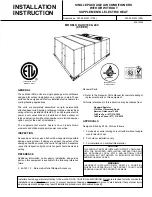
PILOT CHECKOUT
The pilot flame should envelope 3/8 inches of the end of the
flame sensor. Refer to Figure 10. To adjust pilot flame, (1)
remove pilot adjustment cover screw, (2) adjust the screw for
the proper pilot flame, (3) be sure to replace cover screw after
adjustment to prevent possible gas leakage.
Put the system into operation and observe through complete
cycle to be sure all controls function properly.
BURNER INSTRUCTIONS
To check or change burners, pilot or orifices, CLOSE MAIN MANUAL
SHUT-OFF VALVE AND SHUT OFF ALL POWER TO THE UNIT.
1. Remove the two screws holding either end of the manifold
to the burner supports.
2. Open the union fitting in the gas supply line just upstream of the unit
gas valve and downstream from the main manual shut-off valve.
3. Remove the gas piping patch plate.
4. Disconnect wiring to the gas valve and spark ignitor.
Remove the manifold-burner gas valve assembly by lifting
up and pulling back.
Burners are now accessible for service.
Reverse the above procedure to replace the assembly. Make sure
that burners are level and seat at the rear of the heat exchanger.
BURNER AIR SHUTTER ADJUSTMENT
Adjust burner shutters so that a distinct, sharp, blue flame is
obtained. Refer to Figure 11.
SUPPLY AIR BLOWER AND TEMPERATURE RISE
ADJUSTMENTS
The speed of the supply air blower will depend on the required
CFM, the unit accessories and the static resistances of both
the supply and the return air duct systems. With this
information, the speed for the supply air blower can be
determined from the blower performance and accessory static
resistance data in Tables 4,6,8 and 9.
Knowing the required blower RPM and the blower motor HP,
the speed setting for the supply air motor can be determined.
The setting (turns open) for the optional belt-drive supply air
motor pulley can be determined from Table 17.
OPTIONAL BELT-DRIVE BLOWER
All units with belt-drive blowers have single-speed motors. The
variable pitch pulley on the blower motor can be adjusted to
obtain the desired supply air CFM. Refer to Table 7 for blower
motor and drive data. The tension on the belts should be
adjusted as shown in Figure 12.
Start the supply air blower motor. Adjust the resistances in both
the supply and the return air duct systems to balance the air
distribution throughout the conditioned space. The job
specifications may require that this balancing be done by
someone other than the equipment installer.
To check the supply air CFM after the initial balancing has been
completed:
1. Remove the (two)
5
⁄
16
" dot plugs from the holes located on the
filter access panel side of the unit.
2. Insert at least 8" of 1/4 inch tubing into each of these holes
for sufficient penetration into the air flow on both sides of
the evaporator coil.
NOTE: The tubes must be inserted and held in a position
perpendicular to the air flow so that velocity pres-
sure will not affect the static pressure readings.
3. Using an inclined manometer, determine the pressure drop
across a dry evaporator coil. Since the moisture on an
FIG. 11 - TYPICAL FLAME APPEARANCE
FIG. 10 - PROPER FLAME ADJUSTMENT
TURNS
OPEN*
BLOWER DRIVE RANGE (RPM)
3 TON
4 TON
5 TON
6 TON
5
4
3
2
1
0
780
842
904
966
1028
1090
790
856
922
988
1054
1120
850
924
998
1072
1246
1220
900
970
1040
1110
1180
1250
*
Pulley can be adjusted in half-turn increments.
TABLE 17 - BELT-DRIVE SUPPLY AIR
MOTOR PULLEY ADJUSTMENT
FIG. 12 - BELT ADJUSTMENT
SPAN LENGTH
DEFL FORCE
* NEVER LOOSEN
(A)
(C)*
(D)
CAUTION
Procedure for adjusting belt tension:
1. Loosen nut (D) from the motor mount.
2. Never loosen nuts (C) from each other while loosening nut (D).
3. Adjust the tension by turning bolt (B).
4. Do not loosen the four nuts (top and bottom) (A); unless additional tensioning
distance is required; immediately re-tighten these bolts if loosened.
5. Use a belt tension checker to apply a perpendicular force to one belt at the
midpoint of the span as shown. The deflection force should be applied
until a specific deflection distance of 4mm (5/32")is obtained. To determine
the deflection distance from normal position, use a straight edge from
sheave to sheave as a reference line. The recommended deflection force
is as follows:
Tension new belts at the max. deflection force recommended for the belt
section. Check the belt tension at least two times during the first 24 hours of
operation. Any re-tensioning should fall between the min. and max.
deflection force values.
6. After adjusting, re-tighten nut (D) against the motor mount taking care not
to loosen nuts (C).
(B)
530.18-N8W
16
Unitary Products Group





































